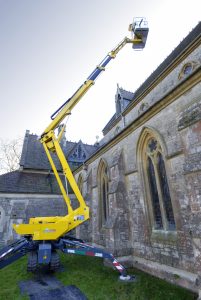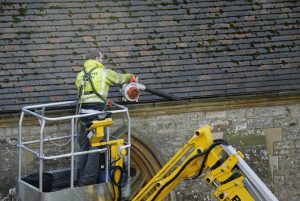by George Allan*
All over Europe, the building conservation movement is confronting the need to find new ways to conserve churches no longer needed for worship. This is a huge challenge which deserves to succeed.

But alongside this is a more basic problem that threatens the success of this effort, at least in some countries, including the UK. Churches must be prevented from going out of use because of neglect. Unless a major effort is mounted, many churches have no future – either as churches in use, or as anything else, because the resources to rescue them from neglect simply do not exist on the scale required.
I estimate that the Church of England’s 12,000 historic churches now have a cumulative repair backlog of £1.5bn, (€1.77bn) which is growing at the rate of at least £70M (€82M) a year.
Maintain our Heritage was founded in 1999 to campaign for better maintenance, across the whole spectrum of building types, by a group of conservationists, academics and journalists. The work of Monumentenwacht in the Netherlands was a major inspiration for us.
We believe that the UK’s major conservation institutions – notably Historic England and the Heritage Lottery Fund – focus virtually all their energies, funds and professional resources on the expensive rescue of ‘buildings at risk,’ often in very poor condition after periods of avoidable neglect.
They do this by perpetuating their long-standing refusal to use their powers to give grants for maintenance, focussing all the available funds instead on repairs – so that the more dilapidated and visibly “at risk” a church is, the more likely it is to receive such grants.
A Culture of Neglect
This, and other factors, has created a culture of neglect. Small rural parishes struggling to give routine care to their church will get no support from these institutions and we have heard of parishes deciding to close down after receiving an estimate for £40,000 (€47,200) worth of repairs for which they are unwilling to make the fundraising effort. In remote rural areas, the church is often the last communal building left after decades of depopulation and its closure can be a catastrophe for the entire population of the area, both for church-goers and others.

Against this background, we set out to campaign for the more efficient application of resources to maintenance. Our founding principle is that any historic building not receiving routine, preventive maintenance is by definition ‘at risk’. By that standard, most historic buildings in the UK are at risk – often long before any more overt threat to their future emerges.
Between 2002 and 2003, we carried out a pilot scheme of a Monumentenwacht-type service in Bath, for all types of historic building. [see photo] This was well received, and although we knew it could not be replicated directly in the UK, for financial and other reasons, we established that there were no technical reasons why such a service could not be provided.
In 2006, we published the results of a major research project, Putting it Off, which analysed the reasons for the culture of neglect. It found that this is not confined to churches or historic buildings; Britain neglects all its buildings: schools, museums & galleries, housing. Other sectors are no better, and almost every year people walking along a UK street are killed by masonry falling from neglected buildings.
A recent study by the Edinburgh World Heritage Site and the Society for the Protection of Ancient Buildings (SPAB) even found that 72% of buildings in the centre of the city needed repairs.
GutterClear in Gloucester
One practical outcome of our Bath pilot was “GutterClear”, a church maintenance promotion scheme in the nearby Diocese of Gloucester, home to 400 of the most important churches in Britain.
The problem is that although Church of England parishes are required to maintain their churches, they often fail to do so, either trying mistakenly to save money, or for lack of volunteer help to reach the often inaccessible heights of their church.
Similar schemes had been set up in other Dioceses but what is unique about GutterClear is that it emphasises the role of competitive contractors and runs with minimal cost.
It works by making it easy for any place of worship (of any denomination or faith) to use the services of a number of accredited local maintenance contractors, working to a standard specification and contract terms, to clear and test every gutter and downpipe regularly, thus dealing with the single most potent source of repair bills. The contractors take “before and after” digital photos, and report back on any problems they see. Some use traditional ladders, and some use mobile access platforms. [see photos]
The scheme is not subsidised, as the parishes using the system deal directly with the contractor and pay the full cost of the service, for which they receive a competitive individual quotation, while remaining free to use any of the contractors – or make their own arrangements as they wish. A web site supports the scheme and enables parishes to seek quotations from the contractors at the click of a mouse. The costs of administering the scheme are low, and are met from funds raised at dinner with HRH Prince Charles, at his home in Clarence House, London, in 2007.
Changes Ahead
Happily, there are now signs of change.
First, the UK Government has appointed an expert review of the “sustainability” of the current repair funding for Church of England churches. Details are now emerging and it is likely that the review will insist on far better standards of maintenance. Schemes such as GutterClear and its equivalents may be created in every Diocese. There are also moves to enable Dioceses to take over the management of parish churches. A vigorous six-year programme of training of parish volunteers by SPAB is, however, sadly coming to a close.

Secondly, the National Churches Trust, a major grant-giving charity, has started a pilot programme to promote routine maintenance in Yorkshire, and has also created a nation-wide grant scheme for small maintenance works for churches . Both of these schemes are funded by the Pilgrim Trust , a private charity, which has rightly decided that its funds available for churches are more effectively spent on maintenance than repairs.
Thirdly, another pilot maintenance scheme – with similarities to Monumentenwacht – has been set up for all historic buildings in Stirling in Scotland, by the Stirling City Heritage Trust , and funded by Historic Environment Scotland.
Conclusion
Looking outwards to the rest of Europe, we draw encouragement from the many successful maintenance schemes in the Netherlands, Germany and Belgium and keep in touch with these, hoping we might develop into a more formal network. We are also keen to contact anyone in other counties without such initiatives, who might be interested in making a start.
Our experience suggests that the path towards a maintenance-led culture can be long and hard – but at least, we have on our side the overwhelming financial and conservation logic of maintenance, which becomes all the more apparent as resources tighten and the inherent wastefulness and unsustainability of the neglect-and-repair cycle becomes painfully apparent.
*George Allan has been a campaigner for historic buildings since his days as a law student. During and after his career as a commercial solicitor in London, he set up local environmental campaigns in London and Kent and helps SAVE Britain’s Heritage on national issues. He was also elected to Islington Council in London and took a full part in its planning and conservation decisions for more than 16 years.
George has always felt the need to campaign for maintenance and co-founded Maintain our Heritage in 1999. He combines his love of European travel with a passion for running and organ music.
Contact Details:





Follow us: